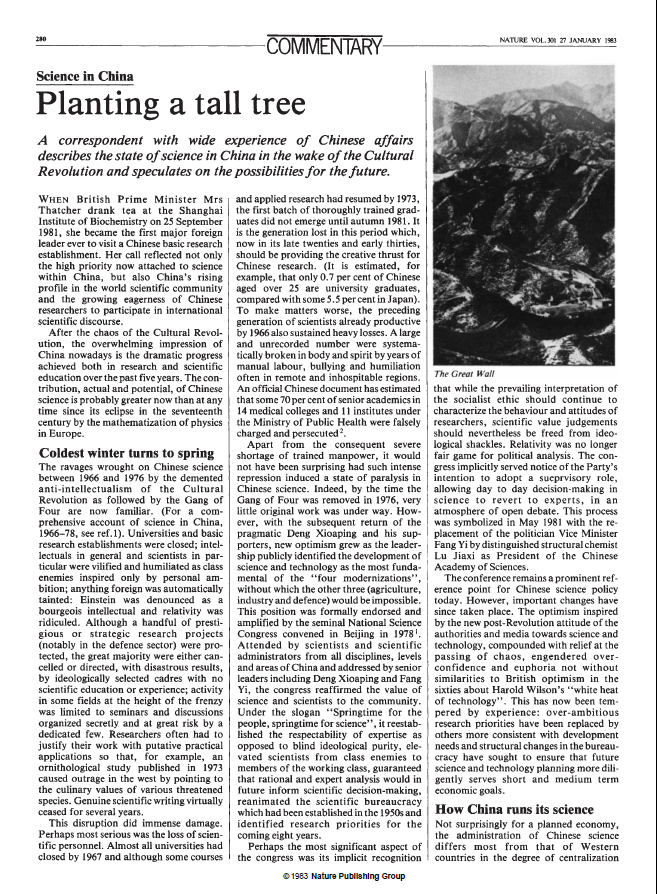摇一摇“招风的大树 ”
钻钻中国科大校史八卦的牛角尖
科大人对这种说法耳熟能详:1984年,英国《自然》杂志撰文称赞中国科大为“招风的大树”,文中说:“在中国,最令人鼓舞的学校要数中国科技大学了,它的蓬勃朝气与成绩给人以深刻的印象。”
但我们发现“招风的大树”的许多引用是不规范的。本文对照《自然》原文及其在《中国科大报》的译文。详细分析了1984年《中国科大报》译文之谬误。
“招风的大树”之谜
瞄上“招风的大树”,事出偶然。因招办要求,我们帮助修改中国科大2007年版招生简章,发现将招风的大树翻译成“USTC is an ‘Attractive Tee’ to perch on”,两个无聊透顶的死心眼衰人动了考古癖,结果挖出不少八卦。
方枪枪发现,不少文章中提到1984年1月27日第301期《自然》根本没有这篇文章,1983年1月27日倒是有一篇。糟糕的是,购买这篇文章需要18美元(够买好多鸡翅啊),普渡菜刀大学居然木有电子版。最后OSU徐三多同学花钱挖出这篇文章。
许多文章中,称1984年《自然》杂志中将中国科大称为“招风的大树”。例如原中国科大党委副书记、副校长李定《坚持实事求是的思想路线 保持思想上的先进性》文章中提到:1984年,英国《自然》杂志撰文称赞中国科大为”招风的大树”,文中说:“在中国,最令人鼓舞的学校要数中国 科技大学了,它的蓬勃朝气与成绩给人以深刻的印象。” 郭传杰书记2007年3月22日《”科大现象”的文化思考》提到:1984年,《Nature》就曾发表文章,评述中国科大不拘一格,敢为人先,是棵“招风的大树”。也有一些文章提到《自然》杂志文章出现在1983年。
经查《自然》杂志,确认该文出现在1983年1月27日第301期刊280-284页评论《Science in China—Planting a Tall Tree》最后一节《Elitism Allowed》。
乱挖校史,挖深挖透
在《中国科大》报1984年4月15日头版二条有秦明译的文章《培养科学英萃的沃土》(附录一)。该文首先提到“编者按:国际上有影响的英国《自然》杂志,在今年一月二十七日的第301期发表了一篇有关中国科技体制中的文章” (作者注:今年显然指1984年)。截至目前,这是我们发现的最早将年代张冠李戴的文章。
年代有误,好歹无伤大雅。但我们却发现了更多对《自然》杂志的错误引用。例如许多文章使用“在中国,最令人鼓舞的学校要数中国科技大学了,它的蓬勃朝气与成绩给人以深刻的印象。” 既然使用双引号,表示原文如此。但《自然》原文应为:But perhaps the most exciting institution in Hefei is the USTC。(在合肥,最令人鼓舞的学校可能要数中国科技大学了)。
“在合肥”与“在中国”,可谓天壤之别,这肯定会让不少科大人感到失望。但《自然》杂志在这篇对中国科技体制的评述之中,对合肥科教城的兴起做了大篇幅的描述,给与了较高评价:Basic science in Hefei is flourishing. [在合肥,基础科学(研究)欣欣向荣];The aim is to construct a “scientific base area” which will become a self-contained centre of excellence, better equipped, and drawing on better talent, than most Chinese research establishments。《自然》单独描述80年代合肥科教基地崛起,事实上把合肥作为中国科教体制最亮点,这种赞颂之后再特别强调“在合肥,最令人鼓舞的学校可能要数中国科技大学了”,也是较高肯定。为求准确,今后我们应避免使用“在中国,最令人鼓舞的学校要数中国科技大学了”这种说法。
“它的蓬勃朝气与成绩给人以深刻的印象”,也非《自然》原文。原文中没有出现完整的一个句子,给出这个评价。《自然》称赞:The only university remaining under the direct control of CAS, better equipped and more imaginatively by younger staff than most of its counterparts, it enjoys increasing success as a cradle for China’s scientific elite. (作为唯一隶属于中科院的大学,它拥有良好的设备;一支更年轻的教师队伍充满活力的运作着这所学校,作为中国科学精英的摇篮,它正取得更多的成功)。Such impressive statistics have not been achieved without controversy.(这些令人印象深刻统计数字的取得不是没有受到非议的。) 认为《自然》称赞科大的蓬勃朝气与成绩给人以深刻的印象,是不夸张的。但绝不使用文中说,“它的蓬勃朝气与成绩给人以深刻的印象”。(双引号绝不能使用),李定校长文章引用的论述是不精确的。
事实上,在《自然》杂志中,甚至没有直接将科大称为“招风的大树”。但原文最后数句提到:In the Cultural Revolution, there were many proverbs in wide use advising against excellence or prominence in any guise. It was said for instance that tall trees bore the brunt of strong winds(树大招风即是一例。). The creative individual in science is now rewarded (albeit modestly) rather than vilified, and at Hefei, tall trees are again being planted 。“在合肥,(招风的)大树正再次被种下”。因此,我们理解,《自然》将中国科大比喻为“招风的大树”,这是基本符合实际的说法。
综上所述,郭传杰书记在《“科大现象”的文化思考》的说法相对谨慎(1984年,《Nature》就曾发表文章,评述中国科大不拘一格,敢为人先,是棵“招风的大树”。 此处不确切的仅有时间,此外“招风的大树”最好不要使用双引号。
谁动了“大树”?——蒙古大夫乱翻译
作者怀疑,载于1984年4月15日的《中国科大报》《培养科学英萃的沃土》,是造成“招风的大树”一些错误说法的由头。例如这篇文章是我们发现最早误认为《自然》杂志在1984年发表的引用。原作者秦明翻译英文,将年代搞错,极不谨慎。
更糟糕的是,秦明翻译,绝非只有这一处错误。我们在仔细核对原文时,发现大量的遗漏、误用,甚至凭空捏造!
翻译有遗漏可以理解,因为 1) 编者按中说明“现摘译有关我校内容供参考。” 既然是“摘译”,删除部分内容,可以理解,但条件是不能断章取义;2)我们理解因为80年代的政治形势,必须删除部分内容。例如秦明译文中的“无论科大怎样标新立异,它还是迅速成为中国主要重点大学之一了。” 原文意为“无论科大在意识形态上如何标新立异,它还是迅速成为中国主要重点大学之一了。” 《自然》一文中还提到:It is impossible to predict when, and under what circumstances, China will be able to claim ”four modernizations have been achieved.(无法预计,将于何时、何种环境下,中国才能声称实现十大现代化)。这种怀疑中国是否能实现四个现代化的评论,为了避免政治麻烦,删除完全可理解。
但让我们感到吃惊的是,秦明居然在原文之后画蛇添足捏造了一句话:看来在科学领域内,中国就需要多培养些冒尖的能“招风”的大树。
我们反复阅读《中国科大报》的原文,编者按中明确说明“现摘译有关我校内容供参考。”,作者署名使用的也是“秦明译”。翻译文章在未经说明的情况下,是不允许评论的;在校报的最后一句话,不能理解为秦明的评述(读者完全无法分辨)。秦明居然硬生生的将这句话塞进去,动机令人费解。这是一个无法饶恕的错误!
此外,秦明似无法读懂英文,创造了令人捧腹的翻译。例如自然杂志称Of some 100 young physics graduate from all over China selected in 1982 by Professor T.D. Li for further study in the United States, 22 were from USTC, including those who came first, second, third and fifth in the selection process.; 秦明翻译为“1982年,来自全国各地的约100名年青的物理学毕业生,被李政道教授选送去美国深造,其中就有22人来自科技大学,这些人都分别通过了第一轮、第二轮、第三轮和第五轮的考试”(作者注:指CUSPEA考试。)而原文作者的意思显然是“第一、第二、第三、第五名均来自中国科大”。秦明诡异的理解成科大的学生通过了第一轮、第二轮、第三轮以及第五轮考试(科大学生齐刷刷全部在第四轮考试中光荣倒下?!) 然而,本则《自然》对1982年CUSPEA的成绩也不准确,根据《中国科大大事记》,中国科大确实有22人通过CUSPEA,成绩是“少年班学生陈永聪个人总分获全国第二名,794李可可、陈侃分别名列第十、第十二名。”(参见中国科大大事记)。真实的史实是:1981年,文小刚(772)、干政(78少)、李源民(774)、吴彦(78少)等4科大学生获得CUSPEA全国第一、二、三、五名。
以下是秦文中的另一些错误:
英文:The only university remaining under the direct control of CAS, better equipped and more imaginatively run by younger staff than most of its counterparts, it enjoys increasing success as a cradle for China’s scientific elite.
秦明译文:科大是唯一的一所隶属于中国科学院的大学,它拥有良好的设备以及较年轻的充满活力的师资队伍,它以成为中国科学的摇篮而著称于世。
正确译法:作为唯一隶属于中科院的大学,科大拥有良好的设备;一支更年轻的教师队伍充满活力的运作着这所学校。作为中国科学精英的摇篮,它正取得更多的成功。
评论:“中国科学的摇篮”应为“中国科学精英的摇篮”。而“著称于世”是个夸大其词的翻译,原文意思只是“它正取得更多的成功”。
英文:Such impressive statistics have not been achieved without controversy.
秦明译文:毋庸置疑,这些使人难以忘怀的统计数字是来之不易的
正确译法:这些令人印象深刻统计数字(或译成“成绩”也可)的取得不是没有受到非议的。
评论:秦明译文中“毋庸置疑”“似乎源于without controversy,此处他显然没有读懂。至于“来之不易”,不知道出自何处,也不算错了。
英文:USTC’s relative unorthodoxy is resented in some circles; attempts were recently made to close its juvenile class, which draws on prodigies as young as 11 years of age from Chinese schools for early university entrance.
秦明译文:科大的一些非正统的做法,在某些方面受到诘难少年班,却是个奇迹,它使哪些来自学校的11岁左右的少年提前进入大学。
正确译文:科大的一些非正统做法,在某些圈子里受到责难。有人企图关闭她的少年班。少年班吸引那些甚至只有11岁的孩子们提前进入大学。
评论:“…在某些方面受到诘难少年班,却是个奇迹,”。“诘难少年班”中间没有断句,读起来令人费解,这或许是编辑排版的错误。我们阅读80年代的科大校报,由于排版系统的限制,类似错误很多,可以理解。但奇怪的是“prodigies”在此处意为“a highly talented child or youth”,秦明却理解成成“an extraordinary, marvelous, or unusual accomplishment, deed, or event”(奇迹)。这完全牛头不对马嘴。考虑到紧随其后就有“as young as 11 years of age”,prodigies此处显然指人而非事件。
Acknowledgement: 感谢俄亥俄州立大学博士生徐三多同学的支持(徐同学当年在科大,人称“皮鞋钉子最多,身上口袋最多,衣服电线最多”,是名“徐三多”)。本文得到中国科大口述校史八卦基金资助(编号:7788)。
作者:老猫、方枪枪:老猫,男,1978年生,毕业于加拿大清水屯农民技校,理学硕士,现在中关村卖红薯。主要研究方向为中国科大校史八卦;通讯作者方枪枪,处男,1980年生,普渡菜刀大学博士,研究方向为计算机编译理论与八卦,现在西雅图Amazon卖尿布。 暗恋通讯作者请将仰慕信发 ![]() 。本文作于2007年4月23日。
。本文作于2007年4月23日。
附录一 培养科学英萃的沃土
喂,看官,俺们花了18美元下载呢,今年给科大捐过碎银子么?捐18美元吧?
“校园文化与体育基金”捐赠方式
—您的公益捐赠可获中国大陆个税减免!
支付宝二维码:手机支付宝扫描即可支付
2)在线捐赠:点击 GIVING.USTC.EDU.CN, 支持多种在线捐赠,快捷支付支持输入信用卡号与密码的闪电捐赠(不需开通网上银行);支持国内各银行网银与信用卡;海外捐赠支持全球Visa、Master、JCB信用卡刷卡捐赠,已在全球15个国家(含港澳台)刷卡成功;
3) 银行账号
户名:中国科技大学北京校友会
账号:8603 8046 6310 001
支行名称:招商银行北京中关村支行
附言:“文体基金”
——英国人眼中的中国科学技术大学
(秦明译,原载《中国科大》报1984年4月15日头版二条)
编者按:国际上有影响的英国《自然》杂志,在今年一月二十七日的第301期发表了一篇有关中国科技体制中的文章,这是目前国外杂志有关这方面的最新评论。现摘译有关我校内容供参考。
在合肥,最令人鼓舞的学校就是要数中国科学技术大学了。科大是唯一的一所隶属于中国科学院的大学,它拥有良好的设备以及较年轻的充满活力的师资队伍,它以成为中国科学的摇篮而著称于世。1982年,来自全国各地的近百名年青的物理学毕业生,被美国学者李政道选送去美国深造,其中就有22人来自科技大学,这些人都分别通过了第一轮、第二轮、第三轮和第五轮的考试。同年,科大有66%的毕业生通过了全国研究生入学考试,而当年全国平均录取率却远远低于0%,毋庸置疑,这些使人难以忘怀的统计数字是来之不易的。科大的一些非正统的做法,在某些方面受到诘难少年班,却是个奇迹,它使哪些来自学校的11岁左右的少年提前进入大学。少年班仍然要办,然而在中国其他大学中是没有类似的班的。无论科大怎样标新立异,它还是迅速成为中国主要重点大学之一了。
从整体上来看,中国的科学依然是相当落后的,但可以肯定,中国实现了“四个现代化”时,一定是基础科学起到了很大的作用,而科学家的作用也得到了充分的认识。文化大革命中,有许多广为流传的格言在一些场合下被用来鼓动人们蔑视成绩突出者,如“树大招风”就是一例,但是,科学上有创造力的人,现在得到的是报酬,而不是非难。在合肥,大树将再次被种起。
看来在科学领域内,中国就需要多培养些冒尖的能“招风”的大树。
附录二 种招风的大树
原载英国《自然》杂志 1983年1月27日301卷(Vol 301)280-284 评论文章《Planting a tall tree ——Science in China》
其中关于中国科大的部分有两处,都在284页,分别在Prognosis和 Elitism allowed Prognosis小节中关于中国科大的部分
China‘s new pragmatic approach to science is exemplified by the growth of the basic research sector around the rather obscure city of Hefei, capital of Anhui Province. A small village before 1949, Hefei is a new town with a population of around 0.5 million. However, despite a relatively prosperous agricultural hinterland and recent growth in local light industry, its industrial base is weak and communications, especially with China’s developed eastern seaboard, are not well developed. Therefore, when the decision was taken in the Cultural Revolution to decentralize science, rendering it (as it was argued) less vulnerable to Soviet attack and at the same time bringing to closer to the masses, Hefei was chosen as a suitable site for the relocation of the University of Science and Technology of China(USTC) formerly based in Beijing. Other important institutes were also moved or newly established there, including the fusion project (now the CAS Institute of Plasma Physics). By the time that the drawbacks of there policies were realized, Hefei’s scientific identity was already established and it would now be impracticable to return the Hefei establishments to their original homes.
Instead, the opposite course is being taken. Basic science in Hefei is flourishing. The research institutes which occupy a large self-contained site some 20 miles from town are being expanded and reequipped. Although the original fusion project has been scrapped, the Institute of Plasma Physics is still constructing a smaller torus, with the benefit of impressive engineering workshops. A new institute of Solid State Physics is under construction, and the fledgling Institute of Intelligent Machines will shortly move there from the centre of town. The aim is to construct a “scientific base area” which will become a self-contained centre of excellence, better equipped, and drawing on better talent, than most Chinese research establishments.
Elitism Allowed
But perhaps the most exciting institution in Hefei is the USTC. The only university remaining under the direct control of CAS, better equipped and more imaginatively run by younger staff than most of its counterparts, it enjoys increasing success as a cradle for China’s scientific elite. Of some 100 young physics graduate from all over China selected in 1982 by Professor T.D. Li for further study in the United States, 22 were from USTC, including those who came first, second, third and fifth in the selection process.; last year 66 per cent of USTC’s graduate passed the national examination for postgraduate positions compared with a national average of well under 20 per cent. Such impressive statistics have not been achieved without controversy. USTC’s relative unorthodoxy is resented in some circles; attempts were recently made to close its juvenile class, which draws on prodigies as young as 11 years of age from Chinese schools for early university entrance. The class is still open, but has no counterpart in other Chinese universities. But whatever the ideological anomalies of USTC, it is rapidly becoming one of China’s most important institutions.
By Western standards, Chinese science, taken as a whole, remains relatively backward. It is impossible to predict when, and under what circumstances, China will be able to claim ”four modernizations have been achieved. But when they are, it is certain that basic science will have played a large part, and that the role of the scientist will be recognized. In the Cultural Revolution, there were many proverbs in wide use advising against excellence or prominence in any guise. It was said for instance that tall trees bore the brunt of strong winds. The creative individual in science is now rewarded (albeit modestly) rather than vilified, and at Hefei, tall trees are again being planted
2014-09-30 上一篇: No More Content! 下一篇: 我要撩美眉,所以巾帼杯





 京公网安备 11010802035836号
京公网安备 11010802035836号